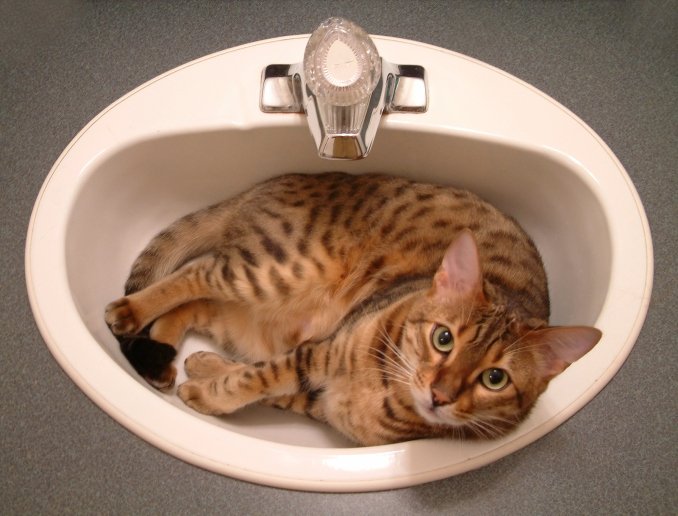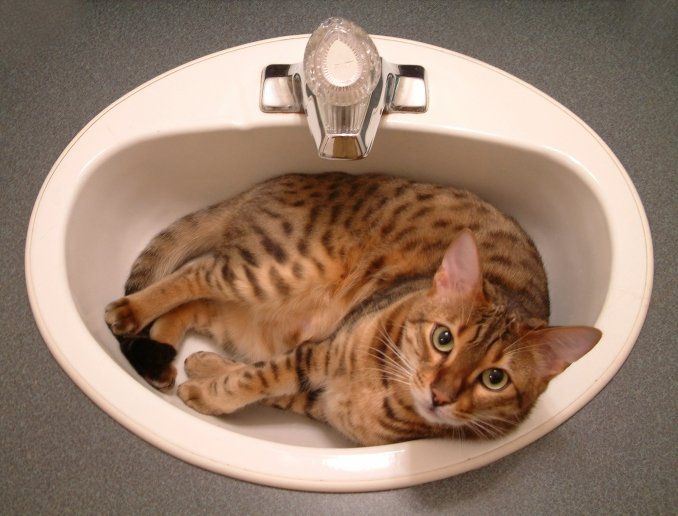Do cats really hate water? It may not seem so when your cat chases a drop from the kitchen faucet. But try giving your adult cat a bath and you’ll likely find out his true opinion.
One reason that some cats will need to be bathed is that they are not always able to groom themselves thoroughly. This is especially true of long-haired breeds that can develop matted fur over a period of time. Another problem is that feces can get stuck in the long hair of the cat’s backside — creating a mess that the cat simply cannot handle on his own. The result is a smelly, dirty cat that needs a bath.
THINKSTOCK

Even short-haired cats can occasionally get themselves dirty or greasy, especially if they are obese and can’t reach the parts that require cleaning. And aging cats sometimes stop grooming as frequently or as thoroughly as they did when they were younger.
Get prepared!
“The first thing you absolutely need to do is to trim your cat’s nails,” explains Susan Smith, a groomer from NYC with 25 years of experience. “When your cat first feels the water, she will probably try to leap out and grab onto anything possible — and you don’t want that to be your arm.”
Giving your cat a good brushing beforehand is a smart idea, too. Loosening as much fur as possible will help make your job that much easier. Especially with a long-haired cat, you should incorporate regular grooming into your schedule to prevent mats, which can become very uncomfortable and require professional intervention if the mats become large enough.
What essential items will you need for the bath itself? You should have at the ready a couple of fluffy towels, a coarse metal comb for removing dirt (or feces) and a brush or comb for your cat’s fur after the bath. Water in the sink or tub should be lukewarm. “Make sure you test it with your arm first,” says Smith. You should buy pet-safe shampoo from your veterinarian or a pet supply store.
Have everything ready before you take your cat in for the bath. If you are using the bathroom sink, put a rubber bath mat or towel on the bottom so your cat can’t slip, and partially fill the sink with lukewarm water. It is helpful to open the shampoo bottle beforehand so you aren’t fumbling with it while you are trying to contain your cat. Keep the comb nearby, and wear clothes that you don’t mind getting soaked —and certainly prepare to mop up the floor afterwards!
The main objective is that once you get your cat into the water, you want to complete the job as quickly and painlessly as possible. To prevent an escape, close the door as soon as you bring your cat into the bathroom.
It’s important to know how to hold your cat when you bathe him. If you don’t have a helper, you will need to be extra careful. “Grasp the cat by the loose skin at the scruff of the neck, just as mother cats do with their kittens,” describes Smith. “This will bring out a natural response: If you control the head, then you can control the rest of the cat’s body.” Even so, expect some crying, yowling and wriggling. Be firm yet gentle, and just work fast!
Gently massage your cat with a solution of one-part shampoo to five-parts water, working from head to tail in the direction of her hair. Take care to avoid the face, ears and eyes. Thoroughly rinse the shampoo off your cat with a spray hose or pitcher with lukewarm water.
Just a touch-up
If you only need to clean part of the cat’s body — such as the rear end — then wrap the cat in a thick, heavy towel and just expose that area. (Your veterinarian or groomer can clip the area if it poses a frequent cleanliness problem.) And if you need to wash your cat’s face, you should use a soft washcloth. “Never spray water in a cat’s face,” emphasizes Smith. “That will just terrify or anger the cat.”
After your cat has been bathed, immediately wrap him in a thick towel and just hold him there for a moment to calm him. After he starts to dry, gently comb out any knots, especially if he has long fur. “You’ll notice that your cat will take a long time to dry, especially if he has long or thick fur,” says Smith.
For that reason, it’s a good idea to confine him to a specific area while he dries. Perhaps keep him in the bathroom with the door closed for a while, or in another room that doesn’t have a lot of dirt and dust that can gather on his wet fur. Make sure that he has access to his food and water bowls, and also a litter box during the drying phase.
Be sure to end the process on a good note — with plenty of praise, affection and a favorite treat. — Catnip staff




